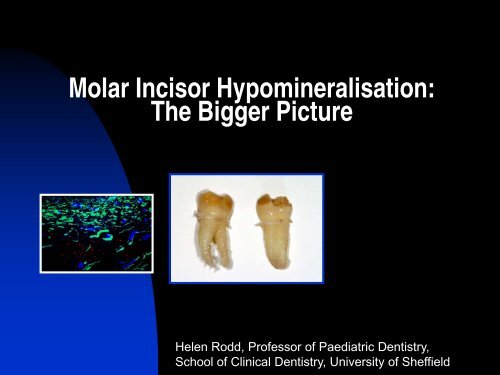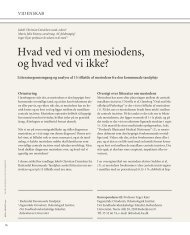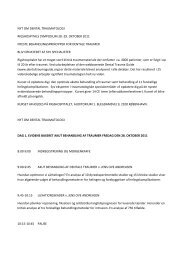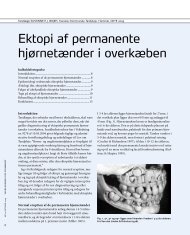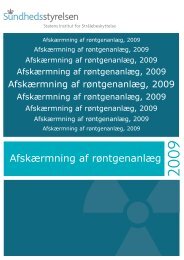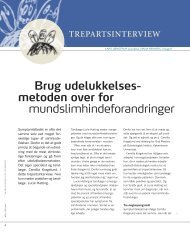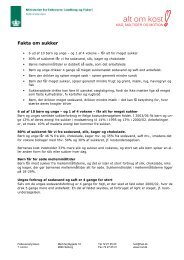Molar Incisor Hypomineralisation: The Bigger Picture
Molar Incisor Hypomineralisation: The Bigger Picture
Molar Incisor Hypomineralisation: The Bigger Picture
Create successful ePaper yourself
Turn your PDF publications into a flip-book with our unique Google optimized e-Paper software.
<strong>Molar</strong> <strong>Incisor</strong> <strong>Hypomineralisation</strong>:<br />
<strong>The</strong> <strong>Bigger</strong> <strong>Picture</strong><br />
Helen Rodd, Professor of Paediatric Dentistry,<br />
School of Clinical Dentistry, University of Sheffield
Today’s challenge…. what can I tell you about MIH<br />
that you don’t already know?
MIH–related publications<br />
Number<br />
Journal special MIH issues<br />
Eur J Paed Dent 2003 v4<br />
Eur Arch Paed Dent 2008 v9 issue 4<br />
16<br />
14<br />
12<br />
10<br />
8<br />
6<br />
4<br />
2<br />
0<br />
2008 1 2007 2 2006 3 2005 4 2004 5 2003 6 2002 7 2001 8<br />
Year of publication<br />
NS Willmott et al. <strong>Molar</strong> <strong>Incisor</strong> <strong>Hypomineralisation</strong>:<br />
A Literature Review. Eur Arch Paed Dent 2008; 9: 173-179.<br />
International symposia<br />
EAPD, Helsinki, May 2009
Lecture aims<br />
To provide an overview of MIH<br />
from the laboratory to the person<br />
To review current data on the prevalence<br />
and aetiology of MIH<br />
To describe laboratory investigations of<br />
the hard and soft tissues hypomineralised<br />
teeth<br />
To highlight challenges in clinical<br />
management of this condition in children<br />
To consider the views and experiences of<br />
children themselves
Is this a new<br />
clinical<br />
condition?<br />
MIH: definition<br />
A clinical diagnosis to<br />
describe<br />
“hypomineralisation of<br />
systemic origin of one to<br />
four first permanent molars,<br />
frequently associated with<br />
affected incisors”<br />
(Weerheijm et al., 2001)<br />
‘idiopathic hypomineralisation’<br />
‘cheese molars’
MIH: clinical presentation<br />
Affected molars present with<br />
well-demarcated<br />
white/yellow or brown/yellow<br />
enamel opacities<br />
1-4 FPMs may be affected,<br />
conflicting data as to<br />
whether maxillary or<br />
mandibular teeth more at<br />
risk<br />
In severe cases, defective<br />
enamel is lost soon after<br />
eruption to expose<br />
underlying dentine
MIH: clinical presentation<br />
Affected incisors also<br />
present with welldemarcated<br />
white/yellow or<br />
brown/yellow enamel<br />
opacities<br />
Post-eruptive enamel loss is<br />
not usually a feature<br />
Increased risk of<br />
hypomineralised incisors<br />
where molars are more<br />
severely affected
Differential diagnosis<br />
Amelogenesis imperfecta<br />
Dental fluorosis<br />
Chronological hypoplasia<br />
Which is hypoplasia and which is<br />
post-eruptive enamel loss?
Chronological hypoplasia <strong>Hypomineralisation</strong><br />
(Now it’s easy!)
MIH: prevalence=3-25%, equal gender distribution<br />
Is it<br />
becoming<br />
more<br />
common?<br />
Percentage Population Study<br />
14%<br />
19%<br />
10%<br />
2,339 Slovenian children<br />
aged 12-18 yrs<br />
488 Finnish children<br />
aged 7-13 yrs<br />
497 Dutch children aged<br />
11 yrs<br />
6% 2,408 German children<br />
aged 10-17 yrs<br />
10%<br />
???<br />
15-25%<br />
18%<br />
3,518 Greek children<br />
aged 5.5-12 yrs<br />
5,277 Danish children<br />
aged 7 yrs<br />
516 Swedish children,<br />
aged 7-8 yrs<br />
Kosem et al., 2004<br />
Leppaniemi et al., 2001<br />
Weerheijm et al., 2001<br />
Dietrich et al., 2003<br />
Lygidakis et al., 2008<br />
Esmark & Simonson,<br />
1995 (in Weerheijm &<br />
Mejare, 2003)<br />
Jalevick et al., 2001<br />
14% 442 Dutch children Jalulaiyte et al., 2008<br />
aged 9 yrs
MIH: underlying mechanisms<br />
Results from an insult to enamel formation<br />
from around 37 weeks to 3 years<br />
Transitional and maturation phase of<br />
enamel is affected – may be reversible or<br />
irreversible damage to ameloblasts with<br />
qualitative disturbance to enamel<br />
formation<br />
Results from protein retention and poor<br />
crystal formation<br />
Can be produced experimentally in rats<br />
with conditions of low pH and low calcium<br />
and phosphate availability
Lygidakis et al. Eur Arch<br />
Paed Dent, 2008;9:207-<br />
217.<br />
88% of Greek children with<br />
MIH (n=360) had known<br />
medical problem vs 19%<br />
recorded medical problems<br />
in control group.<br />
MIH: aetiology/associations<br />
1. Pre-natal<br />
factors<br />
9% of MIH cases<br />
Maternal pyrexia<br />
Medication<br />
Prolonged<br />
vomiting<br />
Maternal<br />
diabetes
Lygidakis et al. Eur Arch<br />
Paed Dent, 2008;9:207-217<br />
MIH: aetiology/associations<br />
2. Peri-natal factors<br />
34% of MIH cases<br />
Caesarean section*<br />
Prolonged/complicated<br />
delivery<br />
Prematurity/low birth<br />
weight<br />
Twins
Lygidakis et al. Eur Arch<br />
Paed Dent, 2008;9:207-217<br />
MIH: aetiology/associations<br />
3. Post-natal factors<br />
34% of MIH cases<br />
Ear/nose/throat infections<br />
Respiratory problems<br />
Pyrexia<br />
Seizures<br />
Prolonged medication<br />
Urinary infections
MIH: aetiology/associations<br />
Most ‘causes’ seem to be<br />
associated with hypocalcaemia<br />
and hypoxia<br />
May also involve a genetic<br />
susceptibility?<br />
No obvious causes in 10-24% of<br />
MIH patients (VanAmerogen & Kreulen,<br />
1995; Jalevik & Noren, 2000)<br />
Conflicting findings regarding role<br />
of environmental pollutants such<br />
as dioxins (Alaluusua et al., 1996; Laisi et al.,<br />
2008)
MIH: Laboratory investigations of hard tissues<br />
Affected enamel is:<br />
very porous – thin irregular enamel rods<br />
with wide inter-rod zones<br />
has significantly lower hardness and<br />
elasticity<br />
has a reduced mineral content (5-20%)<br />
Lower calcium to phosphorus ratio and<br />
increased carbon content<br />
outermost highly mineralised layer<br />
achieves poor etch pattern with<br />
phosphoric acid<br />
cervical enamel usually has a normal<br />
structure
MIH: Laboratory investigations of hard tissues<br />
What about the dentine?<br />
paucity of information on dentine in MIH<br />
no obvious structural changes? (Heijis et al.,<br />
2007)<br />
reduced mineral content? (Fearne et al.,<br />
2004)<br />
Sparse reparative dentine, presence of<br />
interglobular dentine<br />
Influx of bacteria (Fagrell et al., 2008)
MIH: Laboratory investigations<br />
of pulp tissues<br />
Is there is an underlying pulpal<br />
inflammation in MIH teeth?<br />
Rodd HD, Boissonade FM, Day P (2007). Pulpal<br />
status of hypomineralized permanent molars.<br />
Pediatric Dentistry 29: 514-520.<br />
Rodd HD, Morgan CR, Boissonade FM, Day P<br />
(2007). Pulpal expression of TRPV1 in molar incisor<br />
hypomineralisation. European Archives of Paediatric<br />
Dentistry 8:184-188.
Experimental approach<br />
• 25 intact & 19<br />
hypomineralised<br />
molars (9 with intact<br />
enamel, 10 with<br />
missing enamel)<br />
• Mean age of<br />
subjects = 9.4 yrs<br />
• History of sensitivity<br />
to cold/sweet noted<br />
Analysis of -<br />
• pulpal innervation<br />
• immune cells<br />
• vascularity<br />
• TRPV1
MIH: key findings<br />
Significant increases in neural density (green<br />
labelling) in the pulp horn and subodontoblastic<br />
region of MIH samples<br />
Normal MIH
MIH: key findings<br />
Significant increases in immune cell accumulation (red labelling)<br />
in MIH samples, especially with post-eruptive enamel loss<br />
Normal tooth<br />
% area LCA<br />
0.8<br />
0.7<br />
0.6<br />
0.5<br />
0.4<br />
0.3<br />
0.2<br />
0.1<br />
0<br />
Pulp horn Subodontoblastic<br />
plexus<br />
Region of analysis<br />
MIH with post-eruptive enamel loss<br />
Normal Series1<br />
MIH Series2 – enamel intact<br />
MIH Series3 – enamel loss<br />
Mid-coronal region
MIH: key findings<br />
<strong>The</strong>re was a significant increase in vascularity (blue<br />
labelling) in sensitive MIH samples<br />
MIH – non-sensitive<br />
MIH - sensitive
MIH: key findings<br />
<strong>The</strong>re was a significant increase in TRPV1 expression (yellow)<br />
within pulpal nerves and blood vessels of MIH samples<br />
15µm<br />
Normal MIH<br />
% area PGP 9.5 labelled for TRPV1<br />
70<br />
60<br />
50<br />
40<br />
30<br />
20<br />
10<br />
0<br />
B<br />
A<br />
Pulp horn Subodontoblastic plexus Mid-pulp<br />
Intact Hypomineralised<br />
B<br />
A
Why are<br />
these teeth so<br />
sensitive?<br />
MIH: pain mechanisms<br />
Dentine hypersensitivity: porous<br />
enamel or exposed dentine<br />
facilitates fluid flow within dentine<br />
tubules to activate Aδ nerve fibres<br />
(hydrodynamic theory)<br />
Peripheral sensitisation: underlying<br />
pulpal inflammation leads to<br />
sensitisation of C-fibres<br />
Central sensitisation: from<br />
continued nociceptive input?
MIH: clinical challenges<br />
Extreme sensitivity to normally innocuous<br />
thermal, mechanical and chemical stimuli<br />
(tooth brushing, cold, sweet things)<br />
Failure to achieve adequate level of<br />
analgesia for restorative treatment<br />
Anxious and poorly compliant young<br />
patients<br />
High failure rate for adhesive restorations<br />
Rapid caries development in<br />
hypomineralised first permanent molars<br />
(FPMs).
MIH: clinical challenges - supporting studies<br />
A Swedish study of 9-yr-olds with<br />
MIH and matched controls (Jalevik<br />
and Klingberg, 2002) reported:<br />
MIH children were significantly<br />
more anxious about dental<br />
treatment. 44% of MIH children<br />
had dental behaviour management<br />
problems as compared to 2% of<br />
the controls<br />
Restorations placed in<br />
hypomineralised FPMs had failed<br />
at least twice by the age of 9
MIH: treatment considerations<br />
1. Prevention/remineralisation<br />
2. Management of FPMs<br />
3. Aesthetics of incisors<br />
4. Child-centred approach
MIH: preventive considerations<br />
Desensitising fluoridated<br />
toothpastes<br />
Casein-phospho-peptideamorphous<br />
calcium oral care<br />
products (e.g. ‘Tooth mousse’)
MIH: preventive considerations<br />
Fluoride varnishes – regular<br />
applications are advocated to reduce<br />
sensitivity and encourage remineralisation<br />
Strict dietary control is indicated, as<br />
hypomineralised molars are more<br />
susceptible to caries and erosion<br />
Fissure sealants are recommended (but<br />
may have adhesive bond failure in<br />
hypomineralised enamel – pre-use of 5%<br />
sodium hypochlorite? (Mathu-Muju & Wright, 2006)
MIH: management of first permanent molars<br />
Early assessment of long-term prognosis<br />
of FPMs and orthodontic status<br />
Extraction<br />
Extraction at the optimum stage of dental<br />
development is likely to produce an<br />
acceptable occlusal situation (Mejare et<br />
al., 2005. Jalevik & Moller, 2007)<br />
Restoration<br />
(short-, mid-, long-term?)<br />
Aims to reduce sensitivity<br />
& protect hard tissues<br />
50% of 18-yr-olds had an additional<br />
treatment need with life-long cost and<br />
maintenance implications (Mejare et al.,<br />
2005)
Extraction of FPMs of poor prognosis<br />
If necessary, carry out at optimum stage of<br />
dental development (dental age of 9-11 years)<br />
Balancing extractions not indicated unless<br />
contralateral tooth also of poor prognosis or<br />
premolar crowding<br />
Class I cases – usually compensate lower FPM<br />
extraction with upper FPM extraction<br />
Class II cases – try to maintain upper FPMs<br />
unless crowded case and upper FPM is<br />
unopposed and third permanent molars present.<br />
Additional premolar extractions may be necessary<br />
Class III cases – try to restore<br />
(Williams & McMullan, RCS Eng, 2004)
<strong>The</strong> ‘no choice’ case
Too early!
Too late!
Ensure optimum<br />
behaviour management<br />
and analgesia<br />
Restoration of FPMs<br />
resin-modified glass ionomer<br />
composite resin<br />
amalgam<br />
preformed metal crowns<br />
cast onlays/crowns
Adhesive restorations<br />
GICs are useful as a short-term restoration<br />
prior to definitive restoration or extraction (e.g<br />
Fuji Triage, GC America Inc)<br />
composite resins – only indicated for mildly<br />
affected teeth with no cuspal involvement –<br />
margins of restoration should extend beyond<br />
visibly affected enamel
Preformed metal crowns<br />
Advantages:<br />
prevent further tooth deterioration<br />
control tooth sensitivity<br />
establish correct interproximal<br />
contacts and occlusal relationships<br />
not as technique-sensitive or costly as<br />
cast restorations<br />
require little time to prepare and insert<br />
Disadvantages:<br />
adverse reactions in patients with a<br />
nickel allergy<br />
production of anterior open bite if not<br />
fitted correctly<br />
gingival inflammation<br />
not a permanent restoration<br />
Tip – the use of elastic separators may obviate the need for interproximal<br />
tooth preparation
Cast restorations<br />
Indirect gold onlays - are<br />
the restoration of choice for<br />
moderate/severe<br />
hypomineralisation where<br />
the maintenance of FPMs is<br />
indicated in the long term<br />
Placement is usually<br />
considered in the late<br />
mixed or early permanent<br />
dentition
Longevity of posterior restorations in MIH<br />
1. Study of clinical performance of 40 gold crowns and 12 ceramic<br />
crowns in 12 children aged 6-8 yrs found favourable outcome at<br />
2-5 yr follow up for all crowns (Koch and Garcia-Godoy, 2000)<br />
2. Study of 91 children found high level of clinically unacceptable<br />
restorations (at 4-5 yr follow up) in hypomineralised FPMs<br />
(GICs=51% unacceptable, Compomers=36% unacceptable,<br />
Amalgams=22% unacceptable, Composites=16% unacceptable)<br />
(Mejare et al., 2005)<br />
3. Prospective clinical trial of children with variety of enamel<br />
defects found no significant differences in successful outcome of<br />
PMCs vs cast metal crowns (Zagdown et al., 2003)
MIH:management of hypomineralised incisors
Justification for treatment?<br />
Essentially to improve dental<br />
appearance – emerging<br />
evidence to indicate negative<br />
effect of poor dental appearance<br />
on some individual’s<br />
psychosocial status and the way<br />
in which children are judged by<br />
their peers<br />
Decision for treatment should<br />
be made by the child themselves
MIH: management of hypomineralised incisors<br />
Take good clinical photos pre- and post-<br />
treatment, ask child to indicate exactly<br />
which ‘mark’ concerns them<br />
Microabrasion<br />
Microabrasion<br />
& composite<br />
restoration
MICROABRASION<br />
a technique that involves the<br />
chemical (acid) and mechanical<br />
removal of intrinsic and superficial<br />
enamel staining (50-250 microns)<br />
first developed in 1984 – McClosky<br />
(then well described by Croll and<br />
Cavanagh)<br />
safe, effective, conservative,<br />
simple and economical
MICROABRASION Commercially<br />
available as<br />
‘Opalustre’ by<br />
Ultradent<br />
6.6% HCL with<br />
Silicon carbide<br />
Microparticles<br />
Or 18% HCL<br />
mixed with pumice
Pre-microabrasion Post-microabrasion
Pre-microabrasion Post-microabrasion and<br />
thin composite ‘veneer’<br />
Tip – use an opaquer to block out opacities under a composite restoration<br />
(Esthet-X, Dentsply Caulk)
Pre-microabrasion<br />
Post-microabrasion &<br />
thin composite ‘veneer’
MIH: Taking a child-centred approach<br />
Are children satisfied with the<br />
treatment we provide?<br />
What psychosocial impact do ‘marks on front teeth’<br />
have on children and affect their social interactions<br />
with others?<br />
Do visible dental differences<br />
affect a child’s experience<br />
of transition to secondary<br />
school?<br />
What expectations do children have of treatment for<br />
MIH, and what is their role in decision making?<br />
What do children think about preformed<br />
metal crowns?
Rationale………<br />
‘Given it is the child who undergoes the treatment,<br />
and lives with the consequences, it is important that<br />
any research on the effectiveness of interventions<br />
considers not just what clinicians think is in the<br />
child’s best interests, but seeks their own<br />
perspectives, desires and expectations.’<br />
(Mouradian. Angle Orthodontist 1999;69:300-305)<br />
UK National Service Framework for<br />
Children, Young People and Maternity<br />
services, 2004. ‘Services are to be childcentred,<br />
and meet the needs of parents,<br />
children and their families.’<br />
Paucity of oral health research which<br />
engages children as active participants.<br />
(Marshman et al., Int J Paed Dent, 2008.)
Management of visible enamel defects:<br />
seeking children’s perspectives<br />
Yesudian G, Abdul-Karim A, Marshman Z and Rodd HD. Int J Paed Dent, 2009.<br />
Aim: to explore how children felt before,<br />
and after, cosmetic improvement of their<br />
discoloured permanent incisors<br />
Instrument: Development of specific<br />
patient satisfaction questionnaire, based on<br />
qualitative responses from 32 children,<br />
aged 7-16 years, who had received<br />
microabrasion ± composite restoration for<br />
permanent incisor with enamel defect.
Participants and method:<br />
A 10-item questionnaire, developed with<br />
children themselves, was sent to 88<br />
patients who had received microabrasion<br />
and/or composite restorations, for a variety<br />
of enamel defects, at Sheffield Dental<br />
Hospital, UK.<br />
Responses were graded using a 10cm<br />
visual analogue scale (VAS) where a score<br />
of 10 represented the most negative<br />
response, and zero, the most positive.<br />
Additional comments were invited.
Results:<br />
Anonymous replies were<br />
received from 62 children (70%<br />
response rate)<br />
Mean age of participants was<br />
11.9 years (range 7-16)<br />
42% were male, 58% were<br />
female<br />
55% reported teasing at school<br />
No significant differences in<br />
responses according to gender,<br />
with the exception that, before<br />
treatment, girls were reportedly<br />
more worried about their teeth<br />
than boys (P=0.012,<br />
independent t-test).<br />
Pre-treatment, children were found to be<br />
very concerned about their front teeth<br />
Qu 1. Did you feel worried about your front teeth? Mean VAS=6.8<br />
I wasn’t worried at all I was very worried<br />
Qu 2. Were you embarrassed about your front teeth? Mean VAS=6.9<br />
I wasn’t embarrassed at all I was very embarrassed<br />
Qu 3. How yellow or discoloured were your teeth? Mean VAS=7.3<br />
not at all yellow/discoloured very yellow/discoloured<br />
Post-treatment, children felt much better<br />
about themselves and their teeth<br />
Qu 4. Do your teeth look better after your treatment? Mean VAS=1.1<br />
<strong>The</strong>y look much better <strong>The</strong>y look worse<br />
Qu 5. How happy are you now with your front teeth? Mean VAS=2.2<br />
I am very happy I am very unhappy<br />
Qu 6. How confident are you now after your treatment? Mean VAS=1.6<br />
I feel much more confident I don’t feel more confident<br />
Feedback about treatment was positive<br />
Qu 7. Were the staff on our clinic friendly? Mean VAS=0.4<br />
<strong>The</strong> staff were very friendly <strong>The</strong> staff were very unfriendly<br />
Qu 8. How well did the dentist explain things to you? Mean VAS=0.6<br />
<strong>The</strong>y explained everything well <strong>The</strong>y did not explain things at al all
Individual comments<br />
‘Is there anything else you would like to<br />
tell us…?’<br />
1. After treatment some children reported a profound<br />
improvement in well being<br />
‘I can not fault my treatment which<br />
has made me gain some confidence,<br />
which has helped me in this difficult<br />
year of exams.’<br />
(Girl, aged 15)<br />
‘I am a lot happier now, people don’t<br />
pick on me.’<br />
(Boy, aged 10)<br />
‘After the treatment I now feel I can<br />
smile again.’<br />
(Boy, aged 11)
Individual comments<br />
‘Is there anything else you would like to<br />
tell us…?’<br />
2. But in some cases, expectations were not always fully met<br />
‘I was looking forward to seeing my<br />
teeth completely white, but they were<br />
not completely white. <strong>The</strong>y looked<br />
better, but they should have said it<br />
wasn’t going to do all my teeth white.’<br />
(Girl, aged 13)<br />
‘My teeth were treated well, and they<br />
did all they could, but I would like a<br />
little more done to them.’<br />
(Boy, aged 10)<br />
‘<strong>The</strong> initial effect was very encouraging, but over the months<br />
since my treatment ended, the staining is returning, and I am<br />
not as confident about the long term as I was last year.<br />
Thanks for trying though ’ (Girl, aged 14)
Individual comments<br />
‘Is there anything else you would like to<br />
tell us…?’<br />
3. Children felt they had been listened to and were well looked<br />
after by our dental team<br />
‘Everyone was kind and willing to<br />
listen to my own opinion. I do not like<br />
going to the dentist much, but I was<br />
made to feel at ease’<br />
(Girl, aged 13)<br />
‘I was never afraid of my treatment as<br />
it was explained in a way I could<br />
understand.’<br />
(Boy, aged 11)<br />
‘<strong>The</strong> professor explained things well<br />
and was clear about what work would<br />
be done, Thank you.’<br />
(Girl, aged 15)<br />
‘Don’t give to students, they don’t<br />
know what they are doing.’<br />
(Boy, aged 13)
‘’I think my teeth are very clean and I think you did a very good job, thank you.<br />
Since you did a good job, have a sweet!! Don’t forget to brush your teeth. Ha Ha!’<br />
(Ethan, age 12)
Part 2. To be continued………………………!<br />
Acceptability of preformed metal crowns:<br />
children’s and parents’ perspectives<br />
Bell, SJ and Rodd HD. Int J Paed Dent, 2009.<br />
22%<br />
14%<br />
What do you think about your silver<br />
tooth?<br />
Was it ok having the silver cap put on<br />
your tooth?<br />
64%<br />
I really like my silver tooth<br />
64%<br />
I don't mind my silver tooth<br />
29%<br />
I really hate my silver tooth<br />
7%<br />
Yes, it was really easy 64%<br />
It was OK 22%<br />
No, I hated it 14%
Thank you for your attention


